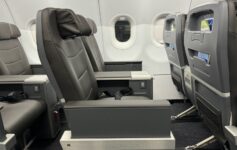American Airlines, like other US carriers, has made an investment in VTOL (helicopter-like aircraft) but it means reducing the passenger ratio dramatically despite a grim pilot shortage outlook.
If you are considering booking travel or signing up for a new credit card please click here. Both support LiveAndLetsFly.com.
If you haven’t followed us on Facebook or Instagram, add us today.
American Airlines Invests In VTOL
American Airlines announced an investment in a VTOL jet company (Vertical Takeoff and Landing) aptly named… Vertical Aerospace. What makes VTOL aircraft advantageous is that, unlike fixed-wing aircraft that need runways, an aircraft capable of vertical takeoff and landing can land anywhere just as a helicopter does.
Some aircraft manufacturers have focused on single or dual occupancy drone-type personal aircraft used as an “Air Taxi.” A pair of military designs have used vertical take off and landing aircraft models. The British Royal Air Force pioneered a fighter jet (later adapted and built by McDonnell-Douglas) called the Harrier which used thrust vectoring through ducted fans and jet engines to create vertical lift before beginning vertical flight once in the air. The Osprey model is closer to Vertical’s design which is a tiltrotor aircraft with propellers that lift straight up as a helicopter before then moving from vertical to horizontal and flying the aircraft forward.
The initial announcement was made in June of 2021, but this week, American Airlines confirmed slot commitments and indicated that it will begin making pre-delivery payments on the first 50 aircraft in a 250-unit order.
“The agreement to make pre-delivery payments and confirm slot reservations for the first Vertical 50 aircraft is the first of its kind for a major airline in the VTOL sector, and it represents a key turning point in their collaboration.” – Airways Magazine
Wait, What About The Pilot Shortage?
Some competing products don’t require a pilot at all, relying on computers and route programming (with safety backup systems) to deliver passengers and cargo to their destinations. Vertical’s type, however, indeed does require a pilot:
“It is anticipated that the VX4 will be able to carry a pilot and up to four passengers, cover more than 100 miles, reach top speeds of more than 200 miles per hour, and operate with no emissions. The VX4 is anticipated to revolutionize travel by making advanced air mobility (AM) accessible to an entirely new group of travelers.” – Airways (emphasis mine)
If that isn’t some American Airlines management decision-making at its finest, I don’t know what is. Just to recap, the world is grappling with unprecedented demand, a global pilot shortage, and limited ability for supporting airports to cope with the traffic, and the investment is into undelivered, unproven aircraft with a pilot-to-passenger ratio of up to four passengers?
Granted, the airline needs to invest in the future and granted, the type of pilot required for this might not be the same as what is required for a large passenger jet. However, if the aircraft is to fly over densely-populated areas (the only real use case for this type of product) with human passengers, a significant amount of training will be required.
There is also a possibility that this is a play for pilotless transport at some point but for now, regulatory concerns abound; Merlin is trying to build the pilotless future too. Getting the FAA to approve a one-pilot cockpit is not thought to be imminent at the moment.
That’s no problem for American Airlines in the future, they have it all figured out.
Is This More Corporate Virtue Signalling?
Frankly, this is corporate virtue signaling on a grand scale. Vertical Aerospace, the aircraft designer, has emphasized that their vehicle is electric so this is an environmentally-friendly option. For those in the energy space, “zero emission” vehicles are known as a giant misnomer as while they may not burn fuel to fly, the power plants that supply the electricity required to charge their batteries rely on fossil fuels to provide that electricity. For example, New York still relies on coal for 13.6% of its power supply, and natural gas for another 31.1% so plugging in a VX4 is hardly emission-free.
But I digress…
This “investment” in the future is going to take real cash today and put it into a manufacturer that hasn’t yet produced a viable model. Further, what’s the market for this? Blade offers a compelling product from New York area airports to Manhattan via helicopter, cutting a 45-60 minute commute down to about 5 minutes at a price point of about $200 and a similar occupancy to pilot ratio. Does American foresee this as an add-on? Will they be able to gain a premium on these trips? Are passengers going to connect from London Heathrow to New York JFK, clear customs, and then make their way to a gate for West 30th Street? How much value will it add when American starts its trademark delays 15 minutes at a time until the passengers could have just taken a cab?
Is this a good time to remind our readership that when I type, “invest”, that would be before repaying the bailout funds from COVID relief and despite a massive debt load that is among the highest in the industry?
Conclusion
I can appreciate that there is a need to invest in the future. I can also appreciate that staying ahead of the competition is good for American shareholders and passengers. However, this solution is odd in nature. Other airlines have partnered with Vertical Aerospace in a similar manner (namely Virgin Atlantic, GOL and, Japan Airlines) to overcome the time it takes to get from the airport to the city, but in the US, the FAA is unlikely to approve unmanned aircraft any time soon. To spend real money today in American’s current financial predicament for an aircraft that’s not received approval that currently requires one pilot to just four passengers amid a remarkable pilot shortage is just ridiculous.
What do you think? Is this a wise investment? Do you see a vaiable application for the equipment?




I would like a 747/Concorde/space shuttle pilot to be in charge of any aircraft in which I am traveling. Please.
This sounds like it will be up and running in no time! Stupid is a stupid does. Unions will LOVE!
Might want to check your sources Kyle. You seemed to have pulled NYS out of thin air.
https://bigthink.com/strange-maps/electricity-generation-by-state/
Why not call out, oh I don’t know, Missouri, Nebraska, North Dakota, Kentucky, West Virginia, Kansas, Utah, etc? Anything those have in common perhaps?
Check your facts.
I can’t believe you actually made it through the entire mess. Kudos to you.
I am tangentially involved in this eVTOL space (financing). In talking with some of the Flight Test engineers, pilots and safety people, these aircraft are very light with quick but low power response and many flights will be at very low altitudes subject to frequent turbulence. They say an abundance of vomit bags will be needed in the cabins. Larger and more powerful (noisy) helicopters are not so affected.
Between that and having these machines (Cessna size) fly over our houses at 400 feet or so, public acceptance (onboard and on ground) is an under analyzed business risk. Beware of the incessant cool-aid and hype around this entire sector. Particularly the many images of these vehicles flying between tall buildings in city centers. Pure fantasy.
They should allowed to fly only over some of the existing roads and most freeways.
and then someday you learn that CO2 rises AFTER the temperature increases (Ice cores). Which might make you wonder — what’s causing the temperature to increase? And then there are those cold spots…and meteor sightings and…